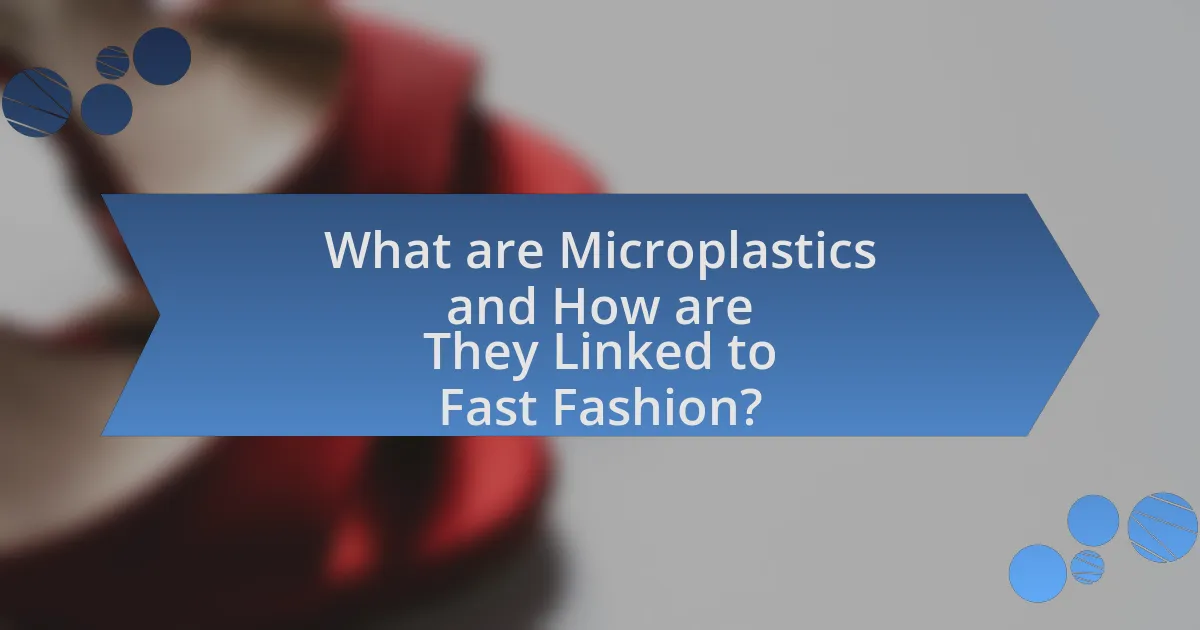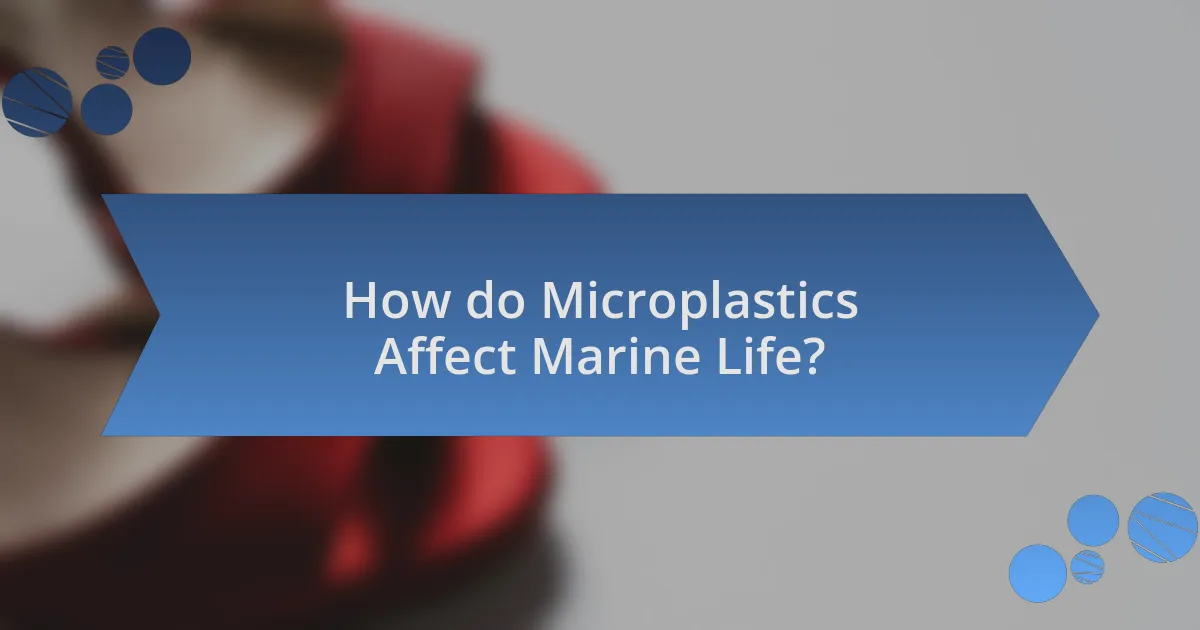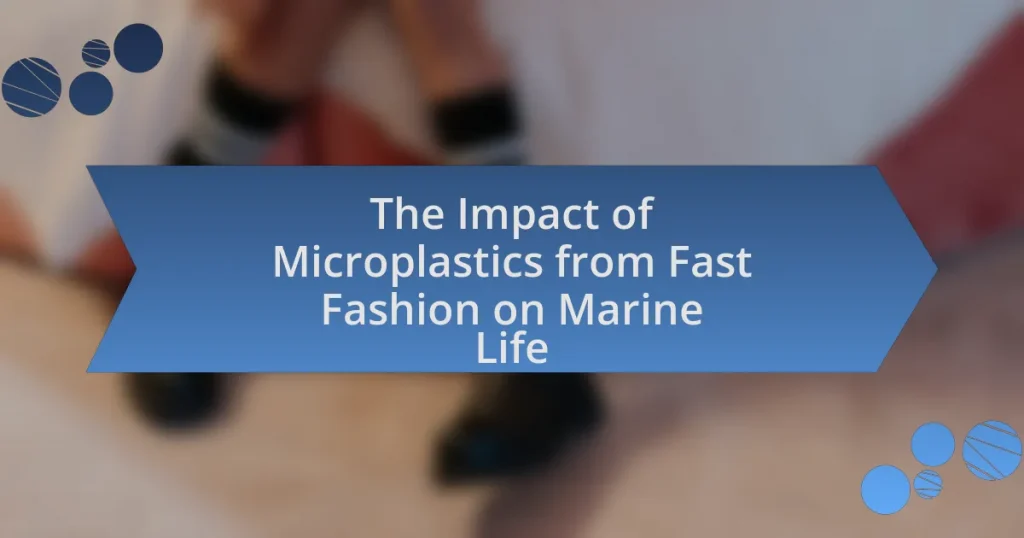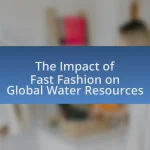Microplastics, defined as plastic particles smaller than five millimeters, are increasingly linked to the fast fashion industry due to the shedding of synthetic fibers during laundry. This article examines the sources of microplastics, particularly from synthetic textiles, and their significant contribution to marine pollution, with an estimated 500,000 tons of microfibers entering oceans annually. It highlights the detrimental effects of microplastics on marine life, including ingestion by various species, disruption of food chains, and potential risks to human health through seafood consumption. Additionally, the article discusses solutions to mitigate microplastic pollution, emphasizing the role of sustainable practices in the fashion industry and consumer behavior in reducing environmental impact.

What are Microplastics and How are They Linked to Fast Fashion?
Microplastics are tiny plastic particles less than five millimeters in size, often resulting from the breakdown of larger plastic items or from the shedding of synthetic fibers during washing. Fast fashion is linked to microplastics primarily through the production and disposal of synthetic clothing, which releases microfibers into waterways during laundering. Research indicates that approximately 500,000 tons of microfibers are released into the ocean annually from washing synthetic textiles, contributing significantly to marine pollution and posing threats to marine life.
What are the sources of microplastics in the environment?
Microplastics in the environment primarily originate from the breakdown of larger plastic items, synthetic textiles, and personal care products. The degradation of plastic waste, such as bottles and bags, contributes significantly to microplastic pollution as these items fragment into smaller particles over time. Additionally, the washing of synthetic clothing releases microfibers, which are a major source of microplastics, with studies indicating that a single wash can release thousands of microfibers into wastewater. Personal care products, including exfoliating scrubs and toothpaste, often contain microbeads that directly contribute to microplastic contamination in aquatic environments.
How does fast fashion contribute to microplastic pollution?
Fast fashion contributes to microplastic pollution primarily through the production and disposal of synthetic textiles. These garments, often made from polyester and nylon, shed microfibers during washing, with studies indicating that a single wash can release over 700,000 microplastic fibers into wastewater. Additionally, the rapid turnover of clothing in fast fashion leads to increased textile waste, which, when discarded, can break down into microplastics in landfills and oceans. Research by the International Union for Conservation of Nature estimates that 35% of microplastics in the oceans come from synthetic textiles, highlighting the significant role of fast fashion in this environmental issue.
What types of materials used in fast fashion release microplastics?
Synthetic materials used in fast fashion, such as polyester, nylon, and acrylic, release microplastics during washing. These materials are prevalent in the production of clothing due to their low cost and versatility. Research indicates that garments made from these synthetic fibers shed significant amounts of microplastics, with a single wash potentially releasing thousands of microfibers into wastewater systems. A study published in the journal Environmental Science & Technology found that polyester is the most common fiber found in microplastic pollution, highlighting the environmental impact of fast fashion on marine ecosystems.
Why is it important to study the impact of microplastics on marine life?
Studying the impact of microplastics on marine life is crucial because these pollutants pose significant threats to aquatic ecosystems and biodiversity. Microplastics can be ingested by marine organisms, leading to physical harm, toxicological effects, and disruptions in food webs. Research indicates that over 800 species are affected by microplastics, which can accumulate in the food chain, ultimately impacting human health through seafood consumption. Understanding these effects is essential for developing effective policies and mitigation strategies to protect marine environments and ensure sustainable fisheries.
What are the potential risks of microplastics to marine ecosystems?
Microplastics pose significant risks to marine ecosystems by disrupting food chains, harming marine organisms, and contaminating habitats. These small plastic particles can be ingested by a wide range of marine species, from plankton to larger fish, leading to physical harm, reduced reproductive success, and even death. Research indicates that microplastics can accumulate in the bodies of marine animals, resulting in toxicological effects due to the chemicals associated with the plastics, such as heavy metals and persistent organic pollutants. A study published in the journal “Environmental Science & Technology” found that microplastics can alter the behavior and feeding patterns of marine organisms, further impacting biodiversity and ecosystem stability.
How do microplastics affect the food chain in marine environments?
Microplastics disrupt the food chain in marine environments by being ingested by marine organisms, which leads to bioaccumulation and biomagnification. When small marine animals, such as plankton, consume microplastics, these particles can transfer up the food chain to larger predators, including fish and marine mammals. Research indicates that over 800 species are affected by microplastics, with studies showing that fish exposed to microplastics exhibit reduced growth and reproductive success. Furthermore, a study published in Environmental Science & Technology found that microplastics can carry harmful pollutants, which may further impact the health of marine species and ecosystems.

How do Microplastics Affect Marine Life?
Microplastics adversely affect marine life by causing physical harm, chemical exposure, and disruption of ecosystems. Marine organisms, including fish, shellfish, and plankton, ingest microplastics, mistaking them for food, which can lead to internal injuries, reduced feeding efficiency, and even death. Studies indicate that over 800 species are affected by microplastic ingestion, with significant implications for biodiversity and food webs. Additionally, microplastics can absorb harmful pollutants from the surrounding water, which then enter the food chain, posing risks to larger marine animals and ultimately humans. Research published in “Environmental Science & Technology” by Rochman et al. (2013) highlights the pervasive nature of microplastics in marine environments and their potential to disrupt biological processes.
What are the direct effects of microplastics on marine organisms?
Microplastics directly affect marine organisms by causing physical harm, chemical exposure, and disruption of biological processes. Marine species, such as fish and invertebrates, can ingest microplastics, leading to internal injuries, reduced feeding efficiency, and impaired growth. Studies have shown that ingestion can result in blockages in the digestive system and decreased nutrient absorption. Additionally, microplastics can leach toxic chemicals, such as heavy metals and persistent organic pollutants, which can accumulate in the tissues of marine organisms, leading to toxicological effects. Research indicates that these contaminants can disrupt endocrine functions and reproductive systems in marine species, further impacting population dynamics and ecosystem health.
How do microplastics impact the health of fish and other marine animals?
Microplastics negatively impact the health of fish and other marine animals by causing physical harm, toxicological effects, and disrupting their ecosystems. Fish and marine animals ingest microplastics, which can lead to internal injuries, reduced feeding efficiency, and impaired growth. Studies have shown that microplastics can carry harmful chemicals and pathogens, further exacerbating health issues. For instance, research published in Environmental Science & Technology found that microplastics can accumulate in the tissues of marine organisms, leading to bioaccumulation and potential toxicity in higher trophic levels. This evidence highlights the significant risks microplastics pose to marine life, affecting not only individual species but also the overall health of marine ecosystems.
What are the behavioral changes observed in marine species due to microplastics?
Marine species exhibit altered behaviors due to microplastics, including reduced feeding rates, impaired predator avoidance, and altered reproductive behaviors. For instance, studies have shown that fish exposed to microplastics demonstrate decreased foraging efficiency, which can lead to increased vulnerability to predators. Additionally, microplastics can disrupt hormonal systems, affecting reproductive success and leading to changes in mating behaviors. Research published in “Environmental Pollution” by Rochman et al. (2013) highlights that microplastic ingestion can cause stress responses in marine organisms, further impacting their behavior and survival.
What are the long-term consequences of microplastic pollution in oceans?
Microplastic pollution in oceans leads to significant long-term consequences for marine ecosystems and human health. These tiny plastic particles, often originating from fast fashion, can be ingested by marine organisms, causing physical harm and toxicological effects. Research indicates that microplastics can accumulate in the food chain, impacting species from plankton to larger predators, ultimately affecting biodiversity and ecosystem stability. A study published in Environmental Science & Technology found that microplastics are present in 100% of marine species tested, highlighting their pervasive nature and potential to disrupt marine life. Additionally, the ingestion of microplastics can lead to the transfer of harmful chemicals into the tissues of marine animals, posing risks to human health through seafood consumption.
How does microplastic accumulation affect biodiversity in marine habitats?
Microplastic accumulation negatively affects biodiversity in marine habitats by disrupting food webs and harming various marine organisms. Marine species, including fish and invertebrates, ingest microplastics, mistaking them for food, which can lead to physical harm, reduced reproductive success, and even mortality. Research indicates that microplastics can carry toxic pollutants, further exacerbating their impact on marine life. For instance, a study published in Environmental Science & Technology found that microplastics can reduce the growth and reproduction of marine organisms, thereby threatening species diversity and ecosystem stability.
What are the implications for human health through seafood consumption?
Seafood consumption can have both positive and negative implications for human health. On the positive side, seafood is a rich source of essential nutrients, including omega-3 fatty acids, high-quality protein, vitamins, and minerals, which contribute to cardiovascular health, brain function, and overall well-being. For instance, studies have shown that regular consumption of fatty fish can reduce the risk of heart disease by up to 36%.
Conversely, seafood can also pose health risks due to contamination with microplastics and toxic substances such as heavy metals and persistent organic pollutants. Research indicates that microplastics can accumulate in marine organisms, leading to potential ingestion by humans, which may result in adverse health effects, including inflammation and endocrine disruption. A study published in Environmental Science & Technology found microplastics in 114 marine species, highlighting the widespread issue of contamination.
Thus, while seafood can be beneficial for health, the implications of consuming contaminated seafood necessitate careful consideration of sourcing and potential risks associated with microplastic ingestion.

What Solutions Exist to Mitigate the Impact of Microplastics from Fast Fashion?
Solutions to mitigate the impact of microplastics from fast fashion include the use of microfiber filters in washing machines, the development of biodegradable fabrics, and the implementation of stricter regulations on textile production. Microfiber filters can capture up to 90% of microplastics released during laundry, significantly reducing their entry into waterways. Biodegradable fabrics, such as those made from organic cotton or hemp, break down more easily in the environment, minimizing long-term pollution. Additionally, regulations can enforce standards that limit the use of synthetic fibers in clothing, thereby decreasing the overall production of microplastics. These strategies collectively aim to protect marine life from the harmful effects of microplastics associated with fast fashion.
What actions can the fashion industry take to reduce microplastic pollution?
The fashion industry can reduce microplastic pollution by adopting sustainable materials, implementing better production processes, and promoting consumer education. Sustainable materials, such as organic cotton, hemp, and recycled fibers, significantly decrease the release of microplastics during washing. For instance, a study by the International Union for Conservation of Nature (IUCN) indicates that synthetic textiles are responsible for 35% of microplastics in the oceans, highlighting the need for alternatives. Improved production processes, including the use of filters in washing machines and wastewater treatment facilities, can capture microfibers before they enter waterways. Additionally, educating consumers about the environmental impact of their clothing choices can encourage responsible purchasing and care practices, further mitigating microplastic pollution.
How can brands implement sustainable practices to minimize microplastic release?
Brands can implement sustainable practices to minimize microplastic release by adopting materials that do not shed microfibers, such as organic cotton or recycled polyester. Research indicates that synthetic fibers, particularly from washing garments, contribute significantly to microplastic pollution, with an estimated 500,000 tons released into the oceans annually from laundry alone. By transitioning to natural fibers or using advanced textile technologies that reduce shedding, brands can effectively decrease their environmental impact. Additionally, brands can promote consumer education on proper garment care, such as using microfiber filters in washing machines, which can capture up to 90% of microfibers before they enter wastewater systems.
What role does consumer behavior play in reducing microplastic waste?
Consumer behavior plays a crucial role in reducing microplastic waste by influencing purchasing decisions and promoting sustainable practices. When consumers opt for eco-friendly products, such as those made from natural fibers instead of synthetic materials, they directly decrease the demand for fast fashion items that contribute to microplastic pollution. Research indicates that approximately 35% of microplastics in oceans originate from synthetic textiles, highlighting the impact of consumer choices on environmental outcomes. By prioritizing brands that utilize sustainable materials and practices, consumers can significantly mitigate the release of microplastics into marine ecosystems.
What are effective strategies for individuals to combat microplastic pollution?
Individuals can combat microplastic pollution by reducing their use of single-use plastics, opting for natural fibers in clothing, and supporting brands that prioritize sustainability. Reducing single-use plastics, such as bags and bottles, directly decreases the amount of plastic waste that can break down into microplastics. Choosing clothing made from natural fibers like cotton or wool instead of synthetic materials like polyester can significantly lower the release of microplastics during washing. Supporting sustainable brands encourages the fashion industry to adopt eco-friendly practices, which can mitigate the impact of fast fashion on marine life. According to a study published in Environmental Science & Technology, washing synthetic textiles releases an estimated 500,000 tons of microfibers into the oceans annually, highlighting the importance of individual choices in addressing this issue.
How can consumers make informed choices when purchasing clothing?
Consumers can make informed choices when purchasing clothing by researching brands’ sustainability practices and understanding the environmental impact of materials used. For instance, many fast fashion brands contribute significantly to microplastic pollution, which adversely affects marine life. According to a study published in the journal Environmental Science & Technology, an estimated 35% of microplastics in oceans come from synthetic textiles. By opting for brands that prioritize eco-friendly materials, such as organic cotton or recycled fibers, consumers can reduce their contribution to this issue. Additionally, checking for certifications like Global Organic Textile Standard (GOTS) can guide consumers toward more sustainable options.
What are some practical tips for reducing microplastic shedding in laundry?
To reduce microplastic shedding in laundry, use a Guppyfriend bag or similar filtration system that captures microfibers during washing. Studies indicate that washing synthetic fabrics releases significant amounts of microplastics, with one load potentially shedding over 1,000,000 fibers. Additionally, washing clothes in cold water and using shorter wash cycles can minimize fiber loss. Research shows that higher temperatures and longer cycles increase shedding rates. Lastly, opting for natural fibers like cotton or wool instead of synthetic materials can significantly decrease microplastic pollution, as natural fibers break down more easily and do not contribute to microplastic accumulation in the environment.















